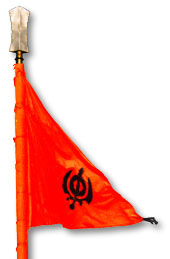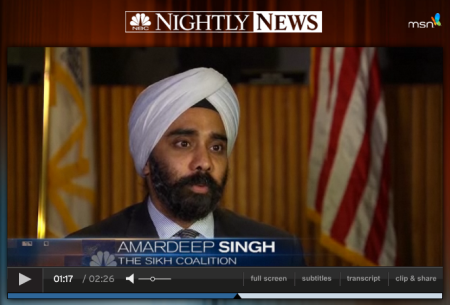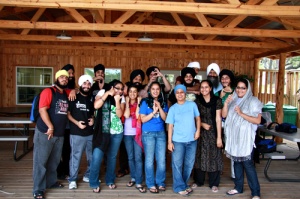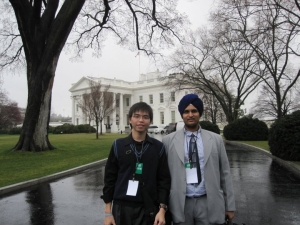Amardeep Singh, Programming Director and Co-Founder of the Sikh Coalition has been on the ground in Oak Creek, WI and gives MSNBC Brian Williams show a view of what’s important in following up to this atrocity.
‘Raghead’ Shirts for Sale on CafePress
February 17, 2012CafePress, one of the largest online retailers in the world, is selling shirts that incite bigotry toward Sikhs. The shirts — which say “No More Ragheads!” and “No More Towelheads!” — are offensive and dangerous, especially in the context of hate crimes against Sikhs in the post-9/11 environment. The Sikh Coalition has issued an open petition to CafePress, demanding that these products be removed and — equally importantly — that the company implement better internal controls to ensure that bigoted products are never sold by the company again. If CafePress has the capacity to market, warehouse, and ship these shirts, surely they have the resources to prevent them from being sold in the first place.
If you believe that CafePress should remove these dangerous products and issue a public apology, with assurances that they will implement better internal controls to keep hateful products off the market, please make your voices heard and sign our petition today.
Why the FBI Refuses to Track Anti-Sikh Hate Crimes
February 10, 2012The recent vandalism of a gurdwara (Sikh house of worship) in Michigan is a sad reminder of the persistence of bigotry. In this context, the Sikh community should be aware of a serious flaw in the way that the federal government monitors anti-Sikh hate crimes:
It doesn’t.
You read that right — the FBI refuses to track anti-Sikh hate crimes, even while Sikh houses of worship are vandalized and Sikh civilians are targeted because of their distinct identity. And that is why the Sikh Coalition encourages you to sign a petition to U.S. Attorney General Eric Holder demanding that the federal government track anti-Sikh hate crimes.
Background
The Federal Bur
Unfortunately, the FBI assumes that all hate crimes against Sikhs are motivated by anti-Muslim bias. In addition, the Sikh Coalition has learned that some FBI officials consider Sikhs to be followers of a Hindu sect. For these reasons, hate crimes against Sikhs are not being accurately documented. Our community remains officially invisible and irrelevant to the FBI, even though Sikhs are usually targeted because of their Sikh identity.
Analysis
We believe that the FBI has the capacity to document anti-Sikh hate crimes. For example, Form 1-699 does an extremely thorough and nuanced job documenting crimes motivated by anti-gay bias, going so far as to maintain distinct categories for anti-lesbian hate crimes and even anti-bisexual hate crimes. In addition, Form 1-699 has been designed to capture data about hate crimes in such far flung places as auto dealerships (for new and used cars), daycare facilities, and amusement parks.
Given the willingness of the FBI to invest time and paperwork into monitoring these other categories, it should not be difficult for them to create a separate category for Sikhs. This is an effective way for the federal government to monitor and allocate resources toward preventing hate crimes against Sikhs. Indeed, how can you diagnose a problem if you don’t even track it?
If you believe that the federal government should track hate crimes against Sikhs, please spare one minute of your time and sign our petition today.
Another TSA Miscalculation?
February 3, 2012The Sikh Coalition has obtained previously unreleased TSA documents. Written in 2009, these documents show that the agency can pursue several auditing options to weed out racial and religious profiling. In addition, the authors of the document apparently miscalculated the effectiveness of Advanced Imaging Technology (AIT) machines, recommending that TSA determine which auditing option to implement “during the interim period of time it takes to deploy advance[d] passenger screening technologies” and claiming “that advance[d] screening technologies, beyond those deployed [in 2009] will reduce or possibly eliminate perceptive profiling[.]” As it turns out, Sikhs are still subjected to secondary pat down screenings, even after passing through AIT machines without incident, and other communities continue to report discriminatory treatment by TSA personnel. In this context, TSA needs to take its auditing options more seriously.
Internal TSA Documents Exposed by Sikh Coalition
Telling Congress to End School Bullying
August 23, 2011An essay by Manpreet Kaur, Sikh Coalition Volunteer Advocate
Securing a meeting with a congressional office to talk about the Safe Schools Improvement Act is something an average citizen might see as a difficult task. I definitely thought so, until I actually did it. One day after requesting a meeting, I received appointments for July 11, 2011 from the offices of Congressman Peter Roskam (IL) and Senator Claire McCaskill (MO). I was set to go to Washington DC and walk the halls of Congress! Many questions filled my mind: How should I present the bill? Can I do this by myself? And most importantly — why does this elected official’s office care to meet me?
After talking to Rajdeep Singh and Amardeep Singh from the Sikh Coalition, my questions started getting answered. I solidified my talking points for the legislation that I would be bringing forward to both offices. Rajdeep helped me join hands with two other organizations that support the bill: GLSEN and the Interfaith Alliance. Amardeep instilled in me the focus of how I, as a constituent, have the duty and power to present the problems of the elected official’s constituency and provide corrective measures. With the focus of the bill correctly in my head, two powerful organizations confirming attendance to join me, and me knowing why I should be presenting this bill, I was ready to conquer these meetings.
The Safe Schools Improvement Act is a proposed federal anti-bullying law. If enacted, it will require schools and school districts to collect and publicize data about incidents of bullying and harassment. This will create incentives for school officials to protect students and allow government agencies to quickly identify schools and school districts where problems exist.
As I arrived at Congressman Roskam’s office, I kept on thinking how important this meeting was and how much I wanted the Congressman to support this bill. My talking points were repeating in my head of how much bullying has increased and why the data-gathering requirement laid out in the bill is necessary. That itself withered away my nervousness as I felt the need to speak about this problem to my Congressman’s office. Accompanying me to the meeting were Rebecca Weidler, the public policy intern from GLSEN; Arielle Gingold, the deputy director of public policy at the Interfaith Alliance; and Rajdeep Singh. After I outlined the problems of bullying in Illinois and the bill proposal to Congressman Roskam’s legislative assistant, Rebecca provided statistics, and Rajdeep and Arielle explained the data collection requirements that schools would need to implement under the law. Within 20 minutes, the meeting was done, and the legislative assistant explained that he would present the bill to Congressman Roskam for consideration.
Later in the afternoon, I met with Senator Claire McCaskill’s office. Having had practice with the earlier meeting, I felt less nervous and more energized to say what I wanted to say. Arielle accompanied me to this meeting along with another policy intern from GLSEN, Noel. The meeting went as smoothly as the one in the morning. I started by outlining the need for the bill; Noel summarized the disheartening statistics of bullying in Missouri; and Arielle wrapped up by discussing the specifications of the bill.
My Capitol Hill experience was beyond what I expected. I never thought being able to walk up to my Congressional offices and talking to Congressional staff about an important issue would be this easy. Building a strong alliance for the meeting was extremely necessary, as it helped convey the bill through different viewpoints for the same cause. As nervous as I was, it was equally rewarding to know I utilized my resources and did my duty as a constituent to engage with my elected officials.
It remains to be seen whether Congressman Roskam and Senator McCaskill will co-sponsor the Safe Schools Improvement Act. They need to hear from more constituents. In the meantime, you can ask your elected representatives to support this important legislation by clicking here to sign a petition telling Congress to end school bullying.
See a Sikh, Call the Cops?
August 4, 2011 Imagine that you are an amateur photographer, taking pictures of landmarks in your city. You are wearing a turban in accordance with your Sikh beliefs and minding your own business. A passerby notices you from a distance, calls the police, and tells them that a man of Middle Eastern appearance is taking pictures of the area. Suddenly, you are surrounded by three police officers, who begin to interrogate you. After several minutes, it becomes clear that you’ve done nothing wrong, but the experience is unsettling nonetheless, because you’ve just been racially profiled.
Imagine that you are an amateur photographer, taking pictures of landmarks in your city. You are wearing a turban in accordance with your Sikh beliefs and minding your own business. A passerby notices you from a distance, calls the police, and tells them that a man of Middle Eastern appearance is taking pictures of the area. Suddenly, you are surrounded by three police officers, who begin to interrogate you. After several minutes, it becomes clear that you’ve done nothing wrong, but the experience is unsettling nonetheless, because you’ve just been racially profiled.
Should you be able to do anything about it?
Not according to most members of the Judiciary Committee in the U.S. House of Representatives. On July 20, 2011, a majority of the Committee approved a proposed federal law titled H.R. 963, The See Something, Say Something Act of 2011. Although the legislation is designed to encourage individuals to communicate freely with law enforcement officials without worrying about frivolous lawsuits—and although this is uncontroversial—there is nothing in the legislation to discourage private individuals and police officers from engaging in racial profiling.
This important point was made during the Committee’s July 20 meeting by California Congresswoman Judy Chu, who offered an amendment that would have addressed profiling concerns, and who condemned racial and religious profiling against Sikhs and other minorities.
Click here to watch her remarks on YouTube
Click here to read about the profiling incident she described
Click here to read a transcript of the full debate, starting at page 157
To be sure, H.R. 963 still needs to be taken up by the entire Congress before it can ever become law, and the Sikh Coalition will work with Senate offices to promote corrective amendments, but the warm embrace the bill received in the House Judiciary Committee underscores the ease with which legislators can discard our most basic civil rights.
A More Constructive Course After bin Laden
May 5, 2011Rajdeep Singh – Director of Law and Policy, The Sikh Coalition
Originally published in the Washington Post. To read the article, click here.
It is impossible to comprehend the depth of sorrow that has been wrought over the years by Osama bin Laden and his gang of criminals, who celebrated the murders of thousands of human beings on 9/11 and shattered the lives of countless more throughout the world. As easy as it might feel for some to celebrate his death with street parties and sloganeering, a more constructive way to mark his death is to vigorously promote peace and interfaith solidarity in our diverse communities. Nothing would hasten the demise of violent extremism more effectively than the construction of a world in which people of all faiths (and no faith) close ranks and work toward their common goals in a spirit of mutual respect and appreciation.
One modest yet important way to contribute to this effort is to judge people not by their appearance but rather by the content of their character. For example, consider just one of the ways in which Osama bin Laden has had a deleterious impact on Sikhs:
The Sikh religion was founded over five centuries ago in South Asia and is presently the fifth largest world religion, with more than 25 million adherents throughout the world. Sikhs are distinguished by visible religious articles, including uncut hair, which Sikh men are required to keep covered with a turban. Although the Sikh turban is a symbol of nobility and signifies a commitment to upholding freedom, justice, and dignity for all people, the physical appearance of a Sikh is often ignorantly conflated with that of Osama bin Laden, whose turbaned and bearded image receives copious publicity in our mainstream media. As a consequence, Sikhs in the United States are ridiculed and stereotyped because of their appearance (often to the point of being openly slurred as ‘Osama bin Laden’) and even subjected to bias crimes, racial profiling, employment discrimination, and school bullying.
Although bigoted oversimplification of this nature might strike many readers as ironic or even patently absurd—akin to casting aspersions on all Europeans (and ‘European-looking’ people) because Hitler happened to be German—many Sikhs look forward to the day when the sight of a turban evokes appreciation instead of apprehension.
Guest Post: the Sikh Research Institute’s Annual Sidak Retreat, June 9 – July 25
May 4, 2011This year, Sidak will be held from June 25 through July 9, and spots are still available. For more information, including what you need to get an application started, please visit: http://www.sikhri.org/sidak-training-development.html, e-mail us at sidak@sikhri.org, or check out our videos here and here.
We’d like to share two stories from a past Sidaker, to let them tell in their own words what the Sidak experience could mean for you.
Education is the First Step
By Ravinder Singh
Sidak 2006 & 2007
It is a rarity to find mentors and teachers who will provide a spark to an inquiring mind. I have found that my experiences at Sidak have led me to seek a better understanding of my faith. The spark I received at Sidak was the beginning of a journey. I set out to learn as much as possible about Sikhi and Gurbani. I wanted to learn about the social and political issues affecting us as a people. From human rights abuses in Panjab to civil rights issues in the diasporas, it is imperative that we become cognizant of the issues affecting us. Once we gain awareness, hopefully we can begin the process of addressing these issues.
Education is the first step and that is what the programs at Sidak provide. In the year following completion of the Sidak program, I was able to help develop lectures and small group discussions for a national Sikh conference. I attended the Sidak program twice in the summers of 2006 and 2007. Three years later, my brother and I still have weekly Gurbani vocabulary quiz sessions.
Sidak was a life changing experience. There are very few programs that can provide a positive influence on one’s life. I am extremely grateful that I had the opportunity to learn at Sidak and I hope others are able to share my experiences by attending Sidak.
Gurmukhi 101: Revealing the Art and Science of Translating the Inscribed Elegance
By Narenderpal Singh
Sidak 2009
The Gurmukhi track at Sidak 2009 is a very structured course whereby high school and college students and adults with either minimal Gurmukhi skills or with fluent modern Punjabi written and spoken skills (or anywhere in between) can learn to translate Gurbani. Two weeks is hardly enough time to learn a language, but the Gurmukhi track at Sidak is presented through detailed course materials, and supplemented with the tools and techniques to help you continue your journey to discover the Guru Granth Sahib Ji for yourself with self-study afterwards.
The instructors at Sidak 2009 were excellent, and they used well-developed course materials to transfer their knowledge to students who came from a wide variety of backgrounds. The proof of their effectiveness of instruction is in the fact that I saw young adults with minimal written and spoken modern Punjabi skills translating shabads on their own in a span of two weeks. The instructors were knowledgeable and passionate about teaching. However, the course is rigorous and has ample homework and it is definitely not for the meek or timid, I think. If you are serious about learning the Gurmukhi used in the Guru Granth Sahib Ji then Sidak is the only place that I know of that will offer the depth and scope to help you extrapolate your existing English and modern Punjabi, or other language skills, to understanding Bani with parts of speech, vocabulary, and techniques of grammar.
The Gurmukhi track at Sidak is unique in that it caters to a diverse audience – those that already are or aspire to become highly accomplished as professionals in field as diverse as engineering, medicine, social studies, psychology, computers, mathematics and law. Students and professionals from almost each of these fields attended Sidak 2009 and student’s ages ranged from late teens to mid-thirties.
The Sidak Gurmukhi track enabled me to leapfrog my understanding of Gurbani from that of a green novice to becoming adequately equipped with tools and techniques to continue through self-study. I am thoroughly impressed by this course and wholeheartedly recommend it for every Sikh and non-Sikh who wishes to learn, translate, and understand Gurbani for themselves. If you are of the mindset that the ancient Gurmukhi of our Gurus that is comprised of a multitude of languages is a rare art form that a select few “back inIndia” could have the privilege of learning properly, then you are in for a pleasant surprise. The Gurmukhi track at Sidak reveals the art and science of Gurmukhi and makes Gurbani accessible to you, even if you do not practice using modern Punjabi in your daily lives! If you have just the desire to learn the word of the Guru Ji in Guru Granth Sahib Ji, then you will come out of this course with enough knowledge, tools and techniques, and literature references to start your journey towards discovery of Dhur Ki Bani by yourself.
Wahe Guru Ji Ka Khalsa Waheguru Ji Ki Fateh
Established in 2003 and located in San Antonio, Texas, U.S.A., SikhRI (http://sikhri.org/) is a non-profit, faith-based initiative whose mission is to “facilitate training and development while inspiring Sikh values, create global awareness of Sikhi, and deliver solutions to the key challenges faced by the Sikh community.
Reflecting on the Power of 1699
April 15, 2011 You have probably heard about the Sikh Coalition’s 16.99 Vaisakhi Campaign. But what is the historical significance of 1699? Consider the following extracts from the writings of historians Gopal Singh, Nikki-Guninder Kaur, and J.D. Cunningham:
You have probably heard about the Sikh Coalition’s 16.99 Vaisakhi Campaign. But what is the historical significance of 1699? Consider the following extracts from the writings of historians Gopal Singh, Nikki-Guninder Kaur, and J.D. Cunningham:
“1699. It was on the first day of Vaisakh, mid-spring … that Guru Gobind Singh [the Tenth Sikh Guru] … decided finally to evolve a new order. Upto now, everyone, Hindu or Muslim, was welcome to the portals of the new faith, if he pledged to forego his caste exclusiveness, interdine, serve man irrespective of his creed and to believe only in one God, and discard all cant, superstition, and ritual. It was a society of the peaceful and the holy.” [GS]
“But it was the martyrdom of Guru Teg Bahadur (the Ninth Guru) in Delhi that finally consolidated the martial aspect of Sikhism. [Guru Teg Bahadur] challenged the policy of the Muslim rulers of converting Hindus by force, and for this defence of religious freedom he was executed in 1675. His son and successor … though only nine years of age then, provided vigorous leadership to the Sikhs. His first task was to infuse a new spirit among his people.” [NGK]
“The Guru, therefore, decided to evolve an order which would keep as its ideal of life nothing but sacrifice for the cause of [righteousness], and would not accept slavery, either political, or social or economic. And, if for this they had to fight their way through, they wouldn’t shirk the use of arms.” [GS]
“Guru Gobind Singh fulfilled his aspiration for religious freedom in 1699 by inaugurating the Khalsa, the Order of the Pure. It was a casteless and self-abnegating body of Sikhs ready to take up arms to fight against oppression[.] Chanting verses from the Guru Granth [Sahib], Guru Gobind Singh began the initiation into the Khalsa by churning water, poured into a steel bowl, with a double-edged sword. His wife, Mata Sahib Kaur, came forward and dropped sugar crystals into the vessel. Sweetness through the feminine hand was thus mingled with the alchemy of iron.” [NGK]
“The occasion marked a dramatic departure from the past. The five to whom the rites of initiation were administered by Guru Gobind Singh were given the surname of Singh, meaning ‘lion’ and were ever after to wear the emblems of the Khalsa, popularly known [today] as the Five Ks. These were Kesha or uncut hair; Kangha, a comb tucked into the Kesha to keep it tidy; Kara, a steel bracelet symbolizing strength and unity; Kachha, short breeches; and Kirpaan, a sword. Their rebirth into the new order represented the annihilation of their family (caste) lineage, of their confinement to a hereditary occupation, of all their earlier beliefs and creeds, and of the rituals they had so far observed. They were enjoined to help the weak and fight the oppressor. Guru Gobind Singh reiterated [the First Guru, Guru Nanak’s] message to have faith in the One, and consider all human beings equal, irrespective of caste and religion.” [NGK]
“This done, [the Guru] now stood before [his disciples] with folded hands, entreating them to administer the Amrit to him … [and] the Guru was administered Amrit the same way, much to the wonder of his devoted followers. It electrified the atmosphere as nothing else could. It is said many thousand persons were baptized thus on that day at their request[.]” [GS]
“Women were also to wear the five emblems of the Khalsa. As men received the surname Singh, women received the surname Kaur, signifying “princess,” and they retained the name whether single or married. Thus the patriarchal structure of society was modified. Men and women no longer traced their lineage or occupation to the ‘father’; as ‘Singh’ and ‘Kaur’ both became equal partners in the new family of Sikhism.” [NGK]
“A living spirit possesses the whole Sikh people, and the impress of [Guru Gobind Singh] has not only elevated and altered the constitution of their minds but has operated materially and given amplitude to their physical frames. The features and external form of a whole people have been modified and a Sikh chief is not more distinguishable by his stately person and free and manly bearing than a minister of his faith is by a lofty thoughtfulness of look which marks the fervour of his soul and his persuasion of the near presence of the Divinity.” [JDC]
Sources: Gopal Singh, Guru Gobind Singh (1966); Nikki-Guninder Kaur Singh, The Name of My Beloved: Verses of the Sikh Gurus (1995); J.D. Cunningham, History of the Sikhs (1849)
Fighting the Bullying Epidemic – Gurwinder’s Trip to Washington
April 13, 2011I am extremely thankful for the opportunity to share my experiences on bullying at the White House Conference on Bullying Prevention. Attending this conference and meeting other people affected by bullying helped me understand that I am not alone in this struggle. Although there is a lot of work to be done to stop bullying in schools, there are a lot of people around the country fighting this very serious issue.
I grew up in Richmond Hill in Queens, and ever since I can remember, I’ve been treated differently. It wasn’t exactly bullying – that started in elementary school – but the other kids didn’t like me very much. I stood out from the rest of them because my joora made me look different. When I got to elementary school, they used to call me “egg head.” Or they would ask me, “What’s inside there? Is it a potato?” Sometimes my mom would come to school to defend me, but she wasn’t able to do much, because she isn’t fluent in English. Loneliness just became a part of my life.
After 9/11, things became much worse. Kids called me names, and would ask me things like “Are you related to Osama bin Laden?” or “Is Osama bin Laden your uncle?” They called me a “terrorist” or “terrorist’s son.” The kids on the bus used to look at me awkwardly, so I tried to avoid looking at them as much as I possibly could. I would just hide. Once on the bus ride home, someone pulled my patka off my hair. I couldn’t do anything; I was helpless. No one was there to stand up for me, and I didn’t know how to stand up for myself. My mom was the one who did my joora, so I didn’t know how to fix it myself. I had to walk home with my patka off, and my joora open, which was very embarrassing. I was crying, and wondering what I could do.
This conference allowed me the opportunity to hear President Barrack Obama and First Lady Michelle Obama speak on bullying in schools. I discovered that President Obama was also bullied when he was in school, and I realized that I am not alone in my experiences. They both sent a strong message to the country, saying that they take bullying issues seriously.
I also met with other students who are working to address bullying issues in their own schools. One particular individual was Duong Nghe Ly, a kid my age who had joined with other Asian students at his school to fight bullying there. Duong and I were placed in the “In-School Policy” group to have a discussion on bullying. Others in the group included psychologists, professors, parents and other experts on bullying. One mother spoke about her child committing suicide because he could not handle the bullying he experienced. It was difficult hearing about the distress her child had faced. The mother was very strong and I pray that she never faces another situation like that again.
When it was my turn to speak, I introduced myself and explained how I was a youth member of the Sikh Coalition. I then shared one of my bullying experiences in high school where my classmate dumped soda all over my patka. After sharing my story I suggested that the schools should educate students on all religions, including Sikhism, Islam and Judaism, so that all students understand who we are and the values that we believe in. .
After the conference, I ran into KalPen Modi (former star on TV’s “House” and the Harold & Kumar films) on my way out of the White House! I was thrilled to see him, but even more so when I later learned that he had had a role in helping me get invited to the conference.
I would like to thank the Sikh Coalition for giving me this opportunity. This experience meant a lot to my family and me. My mother, who has always supported me, was the happiest person there. I hope to continue to fight against bullying everywhere. There is a long way to go toward eradicating it completely, but I want to reach out to Sikh students to reassure them that there is hope and help available. There is no limit to what you can do!




 Posted by sikhcoalition
Posted by sikhcoalition 

